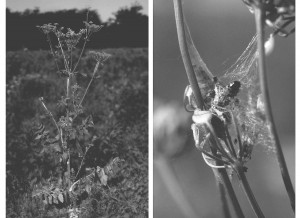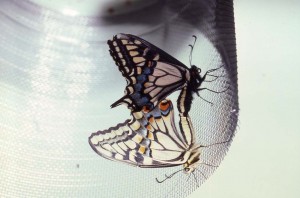How do coevolving interactions vary across ecosystems, and what can we learn from these studies to help preserve coevolutionary interactions into the future amid environmental change?
(NOTE: Names and dates enclosed by parentheses refer to the lead authors of papers listed on the Publications page. Names are listed for only a small subset of the studies so that this webpage does not become sprinkled with too many citations to published studies.)
Each local interaction between a pair of species, or among a group of species, is a mini-evolutionary experiment. By studying the same interaction in multiple ecosystems, we ask how these local populations are genetically connected over large regions, which helps us start to get answers on how coevolution contributes to shaping the web of life over large geographic scales.
Studying the coevolutionary process requires interactions that are distributed across different kinds of environments, are easily studied in the field, and are easily manipulated in experiments. Over the past several decades we studied coevolution in many kinds of antagonistic and mutualistic interactions between plants and other taxa: avian frugivores, insect pollinators, insect herbivores, pathogenic fungi, and mycorrhizal fungi. We have also studied antagonistic interactions between insects and parasitic wasps, competitive between insects, and antagonistic interactions between vertebrates.
Some of the most informative studies have been those between plants and Lepidoptera (butterflies and moths). These have included studies between plants and swallowtail butterflies, oecophorid moths, and prodoxid moths. These studies have provided new results on the ecological and evolutionary genetics of specialization in insects, the genetic divergence of coevolving traits in plants, the ways in which mutualistic and antagonistic interactions differ among ecosystems, and the mechanisms by which populations diverge into potentially new species through interactions with other species.
The diversification of interactions between oecophorid moths and umbelliferous plants. Oeocophorid moths have diversified into a ecologically diverse group of species that differ in the plant species they prefer and the plant parts on which they feed. In my early studies I found great variation among populations in the likelihood that they would be attacked by these moths. The variation suggested that plants may differ in traits preferred by these insects, and I was able to show that some of the variation was related to the positions of the plants within the populations. The pattern of attack by the moths suggested that they may be important agents of natural selection on the plants. These studies also suggested that insects may be important in driving the continuing changing spatial patterns in the plants populations — that is, the “patch dynamics”. The ecological aspects of this work were more informative than the evolutionary aspects, for reasons that we now understand through the subsequent work by May Berenbaum and Art Zangerl.
Just as I was leaving the midwestern U.S., May Berenbaum moved there. She and her research colleague Arthur Zangerl took over these field sites, added others, continued to study them for many years from a variety of perspectives. Most importantly, they analyzed the defensive chemistry of the plants and the chemical counterdefenses in the oecophorid larvae. Their studies showed that much of the variation in oecophorid attack on these plant populations results from variation in the chemical defenses both within and among the populations. They also found considerable variation in the moth’s counterdefenses within and among populations. Collectively, these studies of oecophorid moths and their host plants showed that introduced insects and plants can coevolve in ways that create geographic mosaics of defenses and counterdefenses over just a few hundred years.
In other studies of oecophorids and their hosts in far western North America, I found that closely related species of these moths have evolved different, and sometimes complicated, ways of using their host plants. Some closely related species differ greatly in where and how larval stages feed on the various parts of their hosts. These studies suggested that diversification in some interactions between parasites and hosts may be at least as much about how parasites use hosts as it is about which host species they prefer. See the Publications tab for papers on these studies.
Evolutionary genetics of preference hierarchies in interactions among species. The studies of swallowtail butterflies showed that butterflies in the P. machaon group of species differ in how they rank potential host plants from highest to lowest. These rankings are genetically based and differ not only among species but also, to a lesser degree, among populations within species, and among individuals within populations. Genetic crossing experiments, together with behavioral studies, showed that the differences in ranking between species were controlled by sex-linked genes and some modifier genes on autosomes. (See papers in the Publications section and also summaries in the Thompson (2005; 2013) books.) These studies were the first to show sex-linked preferences for plants in insects. Subsequent studies by other labs have found sex-linked preferences in some other Lepidoptera. Collectively, these studies helped us understand better how webs of interaction develop between plants and insects and why those webs sometimes differ among populations.
Diversification of traits and species in coevolving interactions. Prodoxid moths have also been very useful for studies of coevolution, because some of these interactions can be easily observed in the field and easily manipulated in the lab. Prodoxids include the yucca moths that have coevolved with yuccas as their obligate pollinators, the easily manipulated Greya moths that feed on plants in the Saxifragaceae and Apiaceae, and some other taxa.
The interactions between Greya moths and their hostplants have been particularly useful, because they occur in many different habitats and differ in how they interact with their host plants. When we first started working on these interactions, few species were known and nothing was known about the ecological relationships of any species. I discovered the first host plants of these moths in the late 1970s. Since then, we have discovered, named, and studied the ecological and evolutionary relationships of most of the known species.
We now know that these interactions range from strict parasitism on some hosts to strong mutualism in some species that pollinate their hosts while they lay eggs in the flowers. In this mutualistic interaction, the adult moths pollinate the plants, and the developing larvae eat a small percentage of the developing seeds. The eaten seeds are part of the cost of the mutualism for the plants.
The strongest mutualisms are those between Greya politella moths and woodland star plants (Lithophragma, Saxifragaceae). These interactions are mutualistic in most regions, but in the Pacific Northwest of the U.S. the interactions are commensalistic or antagonistic in local ecosystems because other insects also pollinate the plants at these sites. The traits of the plants and moths appear to differ among populations depending on whether the interaction is mutualistic or antagonistic. (See The Geographic Mosaic Theory of Coevolution tab for more on the coevolutionary process.)
Also in the Pacific Northwest, some populations of the moths have colonized a related plant genus, Heuchera. Although woodland star plants and Heuchera plants co-occur at some sites, the Greya politella moth populations on these different hosts appear to be mostly reproductively isolated.
As Greya moths have colonized new plant taxa and speciated, they have continued to evolve a wide range of ecological interactions with their host plants, ranging from antagonism to commensalism to mutualism.
The closest relatives of Greya moths are the yucca moths, which also have evolved interactions ranging from antagonism to mutualism. Greya moths have diversified solely on eudicots and the yucca moths have diversified on monocots. In both cases, the moths have colonized a wide range of plant parts on their hosts: flowers, seeds, ovary tissue, and various parts of stems. The mutualisms involve the subset of moth species that lay their eggs in flowers or other floral tissues.
The mutualisms between plants and either Greya moths or yucca moths are similar to some other mutualisms between plants and insects. More than a thousand plant species across the globe are pollinated by insects that lay eggs in the flowers they pollinate and have strongly coevolved relationships with these insects that are simultaneously mutualists and antagonists. Some other examples include fig wasps and figs, leafflower moths and leafflower plants, and globeflower flies and globes.
We have placed our coevolutionary studies of plants and Greya moths into a broader phylogenetic, geographic, and ecological context through a series of related studies. We have a molecular phylogeny of the moths and the plants, which has helped us understand how the interaction has diverged as it has spread across large regions. We also have developed a large-scale molecular phylogeographic database for Greya politella, the most widely distributed member of the genus, and contrasted the phylogeographic structure of that species with a more narrowly distributed species that uses the same host plants (See papers by Thompson and Rich.) We have similar phylogenetic and geographic data for parts of the two major lineages of hostplants used by Greya politella: Lithophragma and Heuchera. In addition, we have also conducted studies of some of the parasitic wasps that have evolved to specialize on these moths and differ among species and populations in how they search for the moth larvae (Thompson; Althoff).
As we continue to study these interactions, we continue to find more hidden diversity. We now know that some Greya species are almost morphological identical to each other (cryptic species). See, for example, Thompson et al. (2010) Ecology Letters and Thompson and Rich (2011) Journal of Biogeography. We also know that some of the plant species are effectively complexes of species that differ genomically through whole genome duplication. (See the page on The Genomic Structure of Coevolution.)
Evolution of complex traits in coevolving interactions. In recent years, we have become increasingly interested in how complex traits are shaped by coevolution. Examples include the sizes and shapes of flowers, the chemically complex bouquets of floral scents, and the combination of morphological and behavioral traits that allow pollinating insects to lay eggs in precise positions within flowers while simultaneously pollinating those flowers. Examples include Thompson et al. (2013) Proceedings of the National Academy of Sciences USA and Friberg et al. (2013) Annals of Botany.
These studies bring together many of the most difficult problems in evolutionary biology and evolutionary ecology: how do complex traits evolve; what drives the evolutionary rates of populations; what allows species and interactions with other species to persist sometimes for millions of years amid ongoing environmental change; and how do evolutionary and coevolutionary processes shape the web of life.
We are currently focusing on two questions:
• How do complex traits of coevolving interactions differ among ecosystems across thousands of kilometers, and how does that affect the ecological outcomes of these interactions?
• How does coevolution proceed when multiple species are involved in an interaction rather than just a single pair of species?


